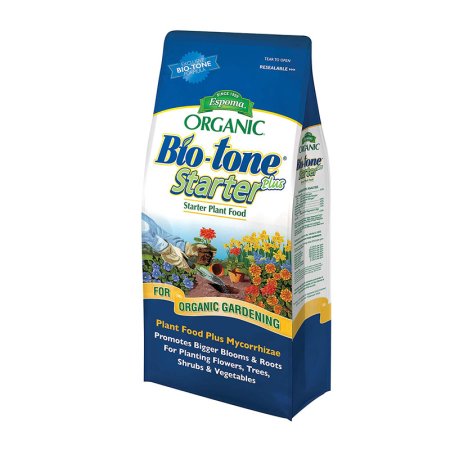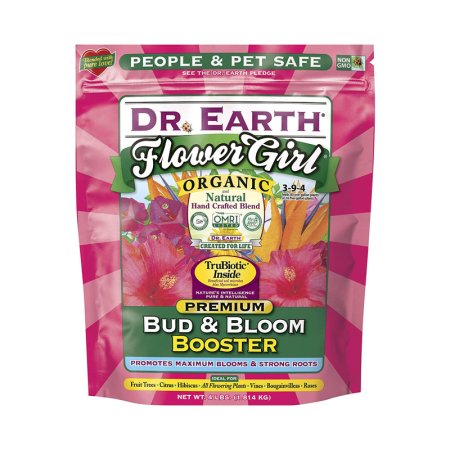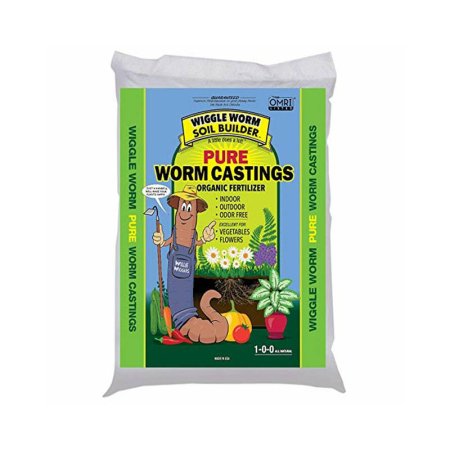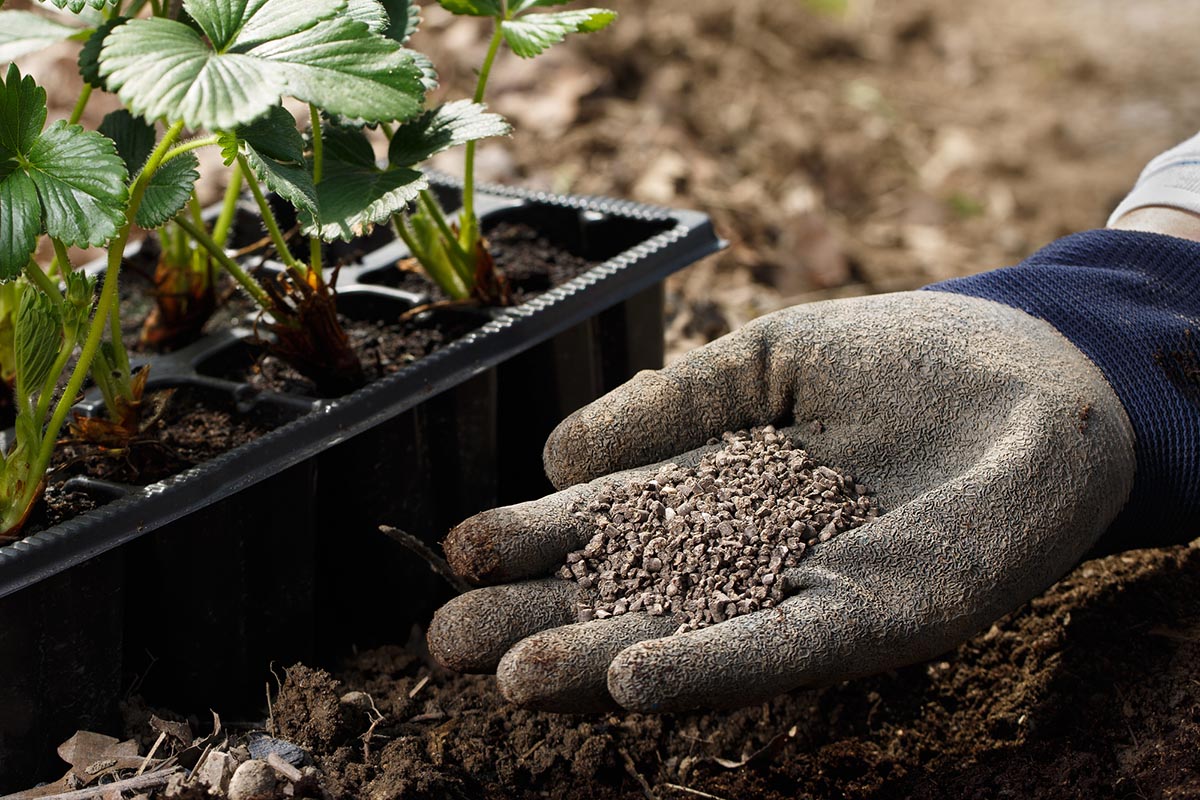
We may earn revenue from the products available on this page and participate in affiliate programs. Learn More ›
Organic fertilizers stimulate and support the natural processes plants use to feed themselves. They make edible or ornamental plants healthier, providing a balance of nutrients, quality ingredients, and an application method that suits the gardener.
In an effort to find the top organic fertilizers that meet common needs and application preferences, we researched dozens of highly rated products, evaluating ingredients, ease of use, and efficacy. With those considerations in mind, our top pick is Jobe’s Organics All-Purpose Granular Fertilizer. It’s fast-acting, easy to apply, and works on almost all plant types. Plus, it only requires reapplication every 4 to 6 weeks during the growing season.
To strengthen our research, we interviewed gardening experts for key advice on selecting and applying fertilizers. Below is a list of some of the best organic fertilizers on the market and shopping tips for finding the right one for domestic plants.
- BEST OVERALL: Jobe’s Organics All-Purpose Granular Fertilizer
↓Jump to Review - BEST BANG FOR THE BUCK: Espoma Plant-tone Organic Fertilizer
↓Jump to Review - BEST ALL-PURPOSE: Neptune’s Harvest Organic Fish & Seaweed Fertiliser
↓Jump to Review - BEST SLOW-RELEASE: Jobe’s Organics All-Purpose Fertilizer Spikes
↓Jump to Review - BEST STARTER: Espoma Bio-tone Starter Plus Plant Food
↓Jump to Review - BEST FOR FLOWERS: Dr. Earth Organic Bud & Bloom Booster
↓Jump to Review - BEST SOIL BUILDER: Unco Industries Pure Worm Castings Organic Fertilizer
↓Jump to Review
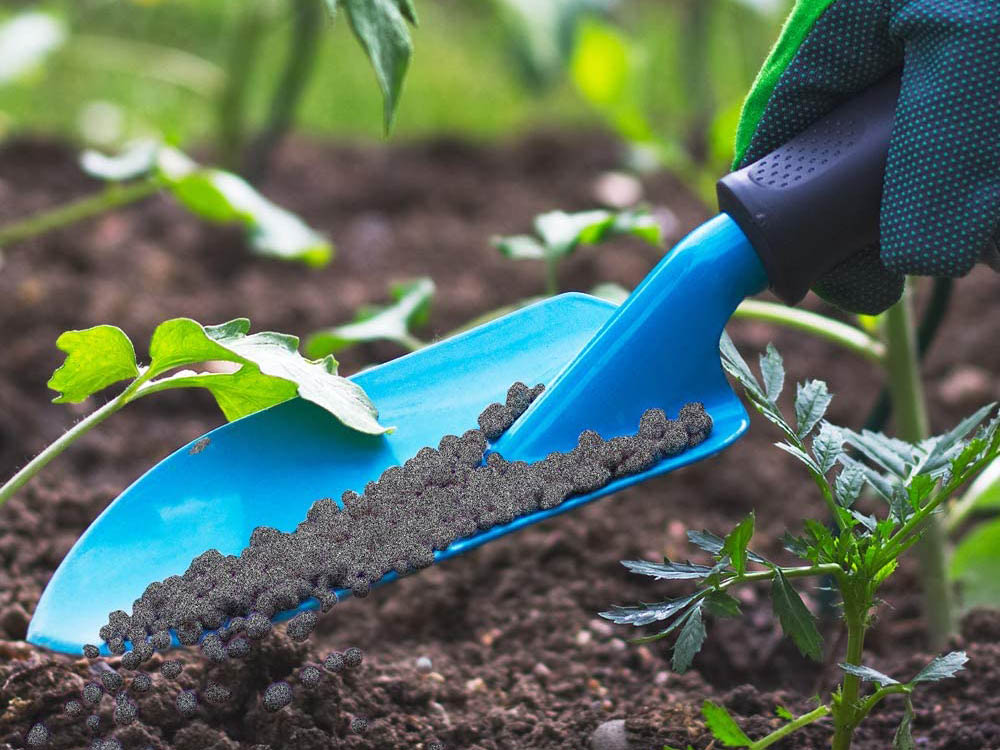
Before You Buy Organic Fertilizer
Because each garden is unique, shoppers may want to assess important factors like drainage, types of plants, weather, soil composition, and preferred application before buying an organic fertilizer. It is recommended that gardeners test the soil pH before choosing a fertilizer since this can affect if and how plants absorb the nutrients in the fertilizer.
Whether they’re sold in liquid or dry form, the best organic fertilizers have an optimal nitrogen-phosphorus-potassium (NPK) ratio, or the percentage by volume of nitrogen, phosphorus, and potassium in the mixture. A high-quality mixture usually consists of natural ingredients like plant scraps, animal waste, and minerals. They’re typically easy to apply, require minimal processing, and maintain a consistent texture throughout.
Before buying and applying an organic fertilizer to houseplants, a garden, or the lawn, shoppers may want to check the label to make sure the mixture doesn’t contain toxic or synthetic ingredients. Organic fertilizers are carbon-based and improve soil health over time by adding organic matter to the soil. They also support biodiversity, increase soil water retention, and do not contain harmful chemicals. However, because they must break down in the soil to benefit the plant, organic fertilizers can take longer to be effective, although they do last longer overall.
Organic Fertilizers Comparison Chart
| Type | Ingredients | Quantity | |
| Jobe’s Organics All-Purpose Granular Fertilizer | Animal-based and mineral-based | Feather meal, bone meal, nitrogen, phosphorus, potassium (potash), processed poultry manure | Available in 1.5-, 4-, 6-, 8-, and 16-pound bags |
| Espoma Plant-tone Organic Fertilizer | Animal-based, plant-based, and mineral-based | Feather meal, poultry manure, bone meal, alfalfa meal, greensand, sulfate of potash, sulfate of potash magnesia | Available in 4-, 8-, 18-, 36-, and 50-pound bag sizes |
| Neptune’s Harvest Organic Fish & Seaweed Fertilizer | Animal-based and plant-based | Fish and seaweed | Available in 18- or 36-ounce bottles, a 1-gallon jug, and a 5-gallon bucket |
| Jobe’s Organics All-Purpose Fertilizer Spikes | Animal-based and mineral-based | Bone meal, feather meal, potassium (potash), and Jobe’s Biozome (a combination of healthy bacteria, mycorrhizal fungi, and archaea) | Available in 50-spike pack |
| Espoma Bio-tone Starter Plus Plant Food | Animal-based, plant-based, and mineral-based | Feather meal, poultry manure, bone meal, alfalfa meal, greensand, sulfate of potash, sulfate of potash magnesia | Available in 4-, 8-, 18-, and 25-pound bags and 5-ounce packets |
| Dr. Earth Organic Bud & Bloom Booster | Animal-based, plant-based, and mineral-based | Fishbone meal, bone meal, alfalfa meal, potassium sulfate, feather meal, kelp meal, kelp flour | Available in 1-, 4-, 12-, and 50-pound bag sizes |
| Unco Industries Pure Worm Castings Organic Fertilizer | Animal-based | Worm castings | Available in 4.5-, 15-, and 30-pound bag sizes |
Our Top Picks
Several well-known brands produce excellent organic fertilizers. The following recommendations take into consideration each product’s NPK analysis, ingredients, application method, and effectiveness in each category.
Best Overall
Jobe’s Organics All-Purpose Granular Fertilizer
What We Like
- Fast-acting granular-style fertilizer enhanced with proprietary microorganisms
- Effective on vegetables, flowers, trees, and shrubs
- Only requires application every 4 to 6 weeks
- Received OMRI Listing
What We Don’t Like
- May cause fungus growth indoors
- Can cause slight eye irritation
Specs
- Type Animal-based and mineral-based
- Ingredient(s) Feather meal, bone meal, nitrogen, phosphorus, potassium (potash), processed poultry manure
- Quantity Available in 1.5-, 4-, 6-, 8-, and 16-pound bags
From Jobe’s Organics, this all-purpose granular fertilizer is a fast-acting and balanced (4-4-4 NPK) From Jobe’s Organics, this all-purpose granular fertilizer is a fast-acting and balanced (4-4-4 NPK) product made from feather meal, bone meal, processed poultry manure, and sulfate of potash. We like that it also includes multiple strains of beneficial archaea, bacteria, and fungi that quickly facilitate the transfer of nutrients to plants. Over time, the microbes in this organic fertilizer work with the plant to improve the surrounding soil structure.
This is an optimal regular maintenance fertilizer for annuals, perennials, edibles, trees, shrubs, and almost all outdoor gardens. An excessive odor may be detected with this product. That odor can be minimized by mixing this fertilizer with soil rather than applying it on the surface.
Get the Jobe’s Organics granular organic fertilizer at Amazon, Ace Hardware, or Walmart.
Best Bang for the Buck
Espoma Plant-tone Organic Fertilizer
What We Like
- Great for all flowers, vegetables, trees, and shrubs
- Ready to use and requires no mixing
- Only requires monthly application during growing season
- 100 percent all-natural and organic ingredients
- USDA-certified biobased product
What We Don’t Like
- Strong odor some users may find unappealing
- Product bag is not resealable
Specs
- Type Animal-based, plant-based, and mineral-based
- Ingredients(s) Feather meal, poultry manure, bone meal, alfalfa meal, greensand, sulfate of potash, sulfate of potash magnesia
- Quantity Available in 4-, 8-, 18-, 36-, and 50-pound bag sizes
Espoma Plant-tone is a slow-release 5-3-3 organic fertilizer derived from feather meal, poultry manure, cocoa meal, bone meal, cottonseed meal, greensand, humates, sulfate of potash, and sulfate of potash magnesia. Added beneficial microbes activate in the garden soil to increase the fertilizer’s efficiency and improve soil structure.
This organic fertilizer for plants is an excellent general-purpose choice for season-long use on flowers, vegetables, trees, and shrubs. It is not meant for houseplants, though, unless they will spend several weeks outdoors. Espoma’s Plant-tone is a high-quality product but can emit a bit of a smell, but that odor can be minimized by mixing it into the soil. Any unused portion can be stored in a sealed container so the scent doesn’t attract animals.
Get the Espoma Plant-tone organic fertilizer at Amazon, Ace Hardware, The Home Depot or Walmart.
Best All-Purpose
Neptune's Harvest Organic Hydrolized Fish & Seaweed
What We Like
- Easy to mix and apply
- Received OMRI Listing
- Effective on vegetables, fruit, houseplants, trees, and more
- Has an indefinite shelf life
What We Don’t Like
- Has a strong fishlike odor
- Must be mixed at each use
Specs
- Type Animal-based and plant-based
- Ingredient(s) Fish and seaweed
- Quantity Available in 18- or 36-ounce bottles, a 1-gallon jug, and a 5-gallon bucket
Neptune’s Harvest has created a 2-3-1 NPK organic liquid fertilizer made from North Atlantic fish and seaweed. Similar to kelp meal fertilizer, this convenient liquid concentrate can nourish most types of plants, indoors and out. Simply mixing the concentrate with water according to the label directions and applying it to the root zone gets the job done.
The high phosphorus ratio stimulates deep root growth and boosts flower and fruit quality. This is a concentrated fish-based fertilizer, so the undiluted concentrate has an odor; however, the smell fades quickly, even when used on indoor plants.
With this organic fertilizer, a little goes a long way. Houseplants require 1 tablespoon per gallon of water, while outdoor plants use ⅛ cup per gallon of water. This product should be handled with gloves while diluting the concentrate.
“After watering my test plants with Neptune’s Harvest for a month, the results were excellent: lush new growth and no symptoms of overfertilization or infestation.”
Mark Wolfe, Staff writer and Product Tester, Best Fertilizer for Indoor Plants
Get the Neptune’s Harvest organic fertilizer at Amazon, Neptune’s Harvest, or Walmart.
Best Slow Release
Jobe’s Organics All-Purpose Fertilizer Spikes
What We Like
- Received OMRI Listing
- Small spikes easy to place near most plants
- Fertilizer spikes are premeasured
- Slow release ensures season-long fertilization
- Odorless for versatile use
What We Don’t Like
- May be too strong for smaller houseplants
- May be appealing to dogs
- Can attract bugs and mold growth
Specs
- Type Animal-based and mineral-based
- Ingredient(s) Bone meal, feather meal, potassium (potash), and Jobe’s Biozome (a combination of healthy bacteria, mycorrhizal fungi, and archaea)
- Quantity Available in 50-spike pack
Jobe’s Organics fertilizer spikes deliver 4-4-4 NPK plant food directly to the plant’s root zone. They Jobe’s Organics fertilizer spikes deliver 4-4-4 NPK plant food directly to the plant’s root zone. We appreciate that these spikes eliminate the mess of handling fertilizer with no required measuring or mixing. The 50 included spikes can be used in indoor or outdoor containers or planting beds.
During the spring or early summer months, inserting the required number of spikes (based on container size or square feet of bed space) around each plant does the trick. The formula’s beneficial microbes help break down the fertilizer for plants, increase soil organic content, and boost plant disease resistance throughout the growing season.
For best results, each spike needs to be fully inserted and covered with soil. Otherwise, several species of mycorrhizal fungi may appear as fuzzy white growth.
Get the Jobe’s Organics organic fertilizer spikes at Amazon, The Home Depot, Walmart, or Target.
Best Starter
Espoma Bio-tone Starter Plus Plant Food
What We Like
- Suitable fertilizer for the garden and more
- Uses microbes to enhance growth
- Does not contain sludges or fillers
- USDA-certified bio-based product
What We Don’t Like
- Strong odor that some may find unpleasant
- Product bag is not resealable
Specs
- Type Animal-based, plant-based, and mineral-based
- Ingredient(s) Feather meal, poultry manure, bone meal, alfalfa meal, greensand, sulfate of potash, sulfate of potash magnesia
- Quantity Available in 4-, 8-, 18-, and 25-pound bags and 5-ounce packets
Bio-tone from Espoma is a 4-3-3 NPK organic fertilizer derived from feather meal, poultry manure, bone Bio-tone from Espoma is a 4-3-3 NPK organic fertilizer derived from feather meal, poultry manure, bone meal, alfalfa meal, greensand, humates, sulfate of potash, and sulfate of potash magnesia, plus 13 species of beneficial microbes.
This blend is unique in its incorporation of humates, which are complex organic molecules formed within the earth during the decomposition of ancient plants and animals. These ingredients neutralize the soil and improve the nutrient uptake of plants. The beneficial microbe mix in Bio-tone includes 10 species of fungi that work in conjunction with plants to increase root mass by up to 30 percent, and healthy roots give plants the best start.
The nutrient mix includes 2.4 percent slow-release nitrogen for an extended feed time. Use this fertilizer at planting time for all outdoor plants, including in the vegetable garden, and when repotting houseplants.
Get the Espoma Bio-tone organic fertilizer at Amazon, Ace Hardware, or Walmart.
Best for Flowers
Dr. Earth Organic Bud & Bloom Booster
What We Like
- Received OMRI Listing
- Effective for fruits, vegetables, trees, and flowering plants
- Quick-releasing formula; single application lasts several months
- Very affordable compared to similar products
What We Don’t Like
- Some user reports of a very strong odor
- May cause mold growth if not applied properly
Specs
- Type Animal-based, plant-based, and mineral-based
- Ingredient(s) Fishbone meal, bone meal, alfalfa meal, potassium sulfate, feather meal, kelp meal, kelp flour
- Quantity Available in 1-, 4-, 12-, and 50-pound bag sizes
Dr. Earth Organic Bud & Bloom Booster is a 3-9-4 NPK fertilizer made from fish bone meal, alfalfa meal, feather meal, soft rock phosphate, and mined potassium phosphate. The high phosphorus content provides ideal conditions for flowering and fruiting plants, including bulbs and rhizomes. No chicken manure or wastewater sludge means no bad smell.
We like that this organic food fertilizer has excellent microbe content, with more than 20 strains of beneficial bacteria and fungi to boost plant immunity and increase nutrient efficiency. Mixing this fertilizer into the soil before planting leads to quick root establishment and heavy yields of flowers and fruit. Dr. Earth fertilizer is primarily manufactured for dry application to be incorporated into the soil ahead of planting or as a maintenance fertilizer for established plants. The label includes directions for making a fertilizer tea as well, which might be beneficial for fruit growers.
Get the Dr. Earth organic fertilizer at Amazon, The Home Depot, Dr. Earth or Walmart.
Best Soil Builder
Unco Industries Pure Worm Castings Organic Fertilize
What We Like
- Natural earthworm castings optimal for plant health
- OMRI-Listed fertilizer provides long-term nutrients for some plants
- Particles improve soil aeration for roots
What We Don’t Like
- Possible bug infestation due to earthworm casting content
Specs
- Type Animal-based
- Ingredient(s) Worm castings
- Quantity Available in 4.5-, 15-, and 30-pound bag sizes
Made from pure earthworm castings, this organic fertilizer from Unco Industries is an ideal soil builder that doesn’t contain any wood chips or other filler. Earthworms are high-level soil builders that consume Made from pure earthworm castings, this organic fertilizer gardening product from Unco Industries is an ideal soil builder that doesn’t contain any wood chips or other filler. The raw materials in this product contain a variety of minerals and trace elements. It also includes a diversity of beneficial microbes that contribute to root development and boost overall plant health and vigor.
The worm castings in this fertilizer for garden use add an odorless, nutrient-rich component to supplement any organic gardening system. Great for indoors or out, this product can be used to fertilize houseplants, flowers, edibles, and other vegetation. At the recommended application rate of just ½ cup per plant or 1 cup per foot of row, a little goes a long way.
Get the Unco Industries organic fertilizer at Amazon or Walmart.
Or, DIY Your Own Organic Fertilizer
While there are some great organic fertilizers that can be bought at a store or online, creating a natural homemade fertilizer saves money, cuts down on product packaging waste, and allows gardeners to reuse natural items that otherwise might be tossed.
Some organic fertilizer recipes are a little complex, with multiple ingredients like gypsum, bone meal, seed meal, and agricultural lime. But it’s possible to keep it simple with just water and weeds. Most people don’t realize that there is already a source of nutritious plant food right in the garden.
Comfrey, stinging nettle, horsetail, or chickweed can be soaked in water to create a weed tea. All you need to do is grab a bucket and fill it halfway with these ingredients, along with roughly chopped leaves, stems, and flowers of weeds. Then, add water and let the bucket sit in the sun for at least a day. When it’s ready, the mixture can be strained and poured into a spray bottle or watering can for application.
Other homemade organic fertilizers include making compost tea using a bucket of water filled with compost, adding coffee grounds to it, and sprinkling it directly on plants—the mixture can also be left to soak in a bucket of water for a day or so to create a spray. Feeding plants banana water is another option.
Jump to Our Top Picks
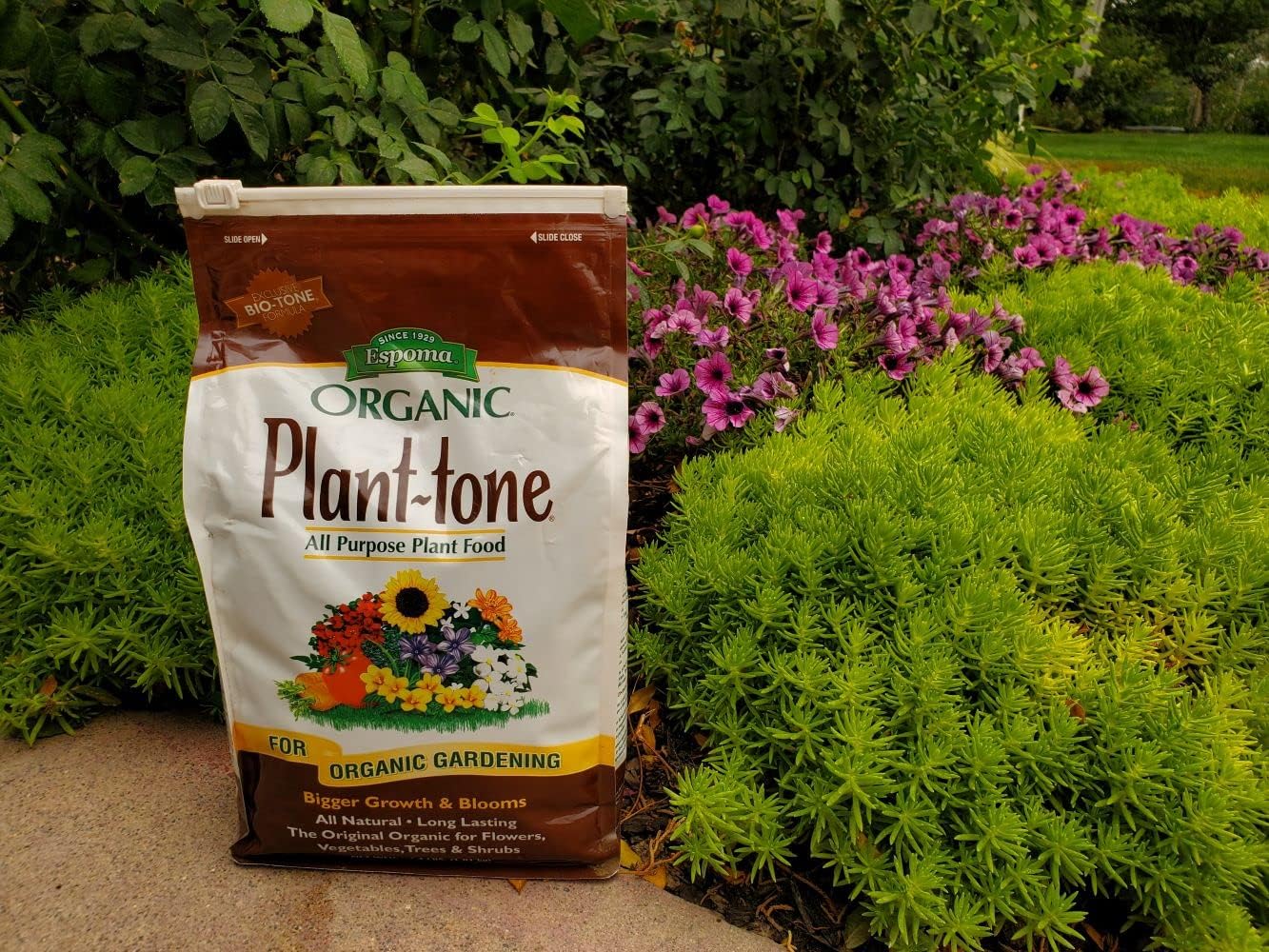
Our Verdict
Jobe’s Organics granular organic fertilizer is our top choice based on ingredients, organic certification, fast-acting quality, and clean and easy application. There are other popular fertilizer options such as Miracle-Gro Shake ‘N Feed and Osmocote Plus. However, they do not meet our sustainability guidelines and are not recommended in our top picks due to harmful synthetic ingredients.
How We Chose the Best Organic Fertilizers
To build our list of the best organic fertilizers available, we researched a variety of ingredients, effectiveness, application methods, and ease of use. Some are made with animal byproducts, which are known to provide excellent fertilization benefits, and others are made with minerals or microbial ingredients. Purists might prefer the animal-based products, but the smell may be too much for some, which is why our top recommendation is a granular fertilizer, which is easy to apply to many kinds of outdoor and flowering plants.
We also considered the type of application: dry, liquid, or foliar. Buyers should be comfortable applying their preferred fertilizer, so we’ve included options to suit most preferences. Certain fertilizers are easy to apply once each season, while others require bimonthly application for best results, which may appeal to green-thumb gardeners.
Finally, we looked for products that contain the Organic Materials Review Institute (OMRI) label. OMRI is a 501(c)(3) nonprofit organization that provides an independent review of products that are intended for use in certified organic production and processing. The organization reviews products like natural fertilizers against organic standards, adding those that meet these standards to its OMRI Products List. It then lets manufacturers include an OMRI List label on the approved product.
What to Consider When Choosing the Best Organic Fertilizer
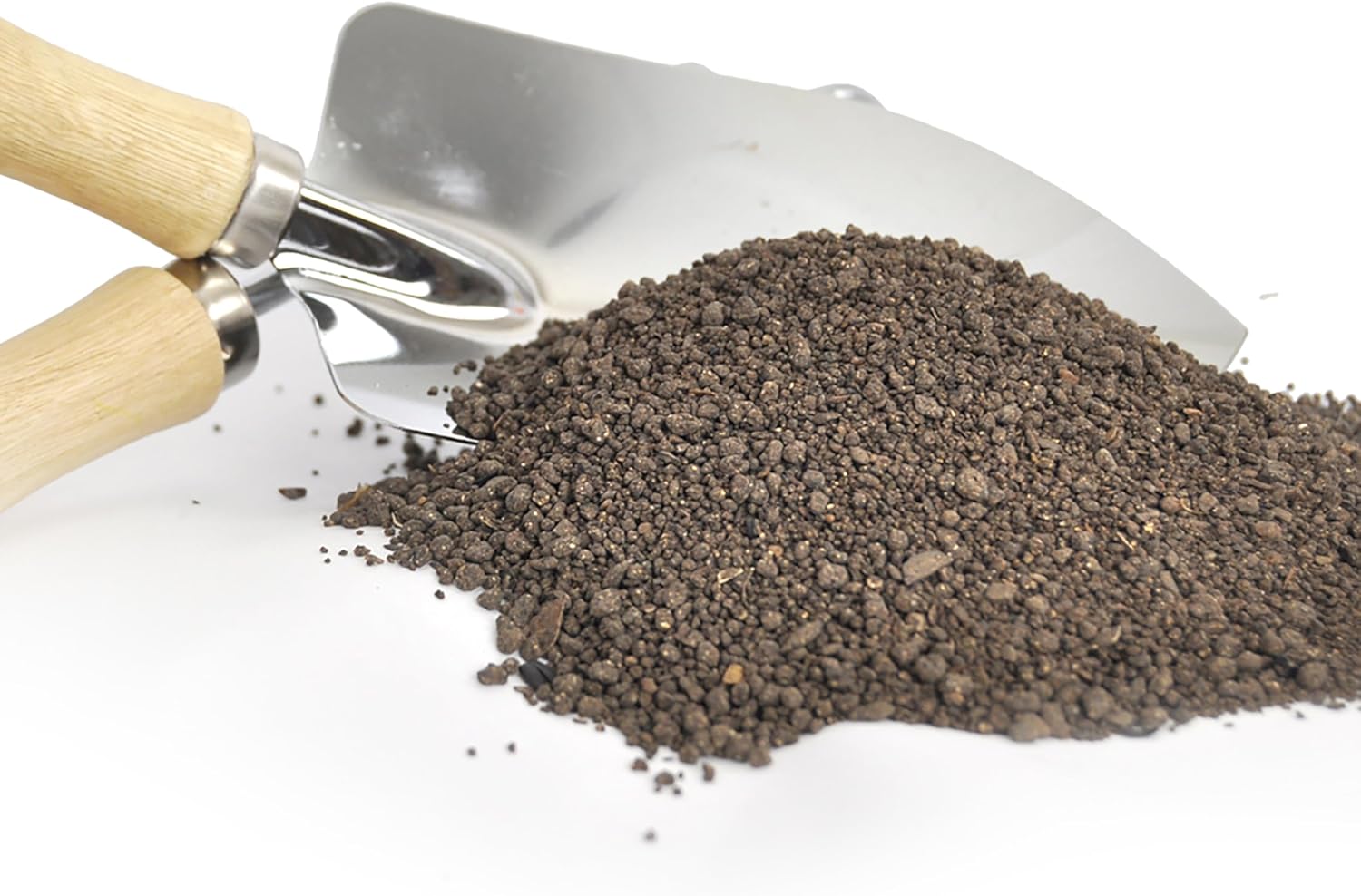
All organic fertilizers are not created equal. Some products act fast, offering season-long feeding, while others offer benefits beyond nutrient delivery. Some fertilizers can even influence soil structure, such as soil pH levels. Here’s a closer look at some top considerations ahead of buying.
Types of Organic Fertilizers
It’s important to choose the right type of fertilizer for a garden. Some products may be entirely plant-based or animal-based. Others may include a combination of plant-, animal-, and mineral-based ingredients. It’s more than a matter of personal choice; these products serve different purposes.
Plant-Based
Plant-based organic fertilizers include such products as compost, cottonseed meal, alfalfa meal, soybean meal, and seaweed. Although cottonseed meal and soybean meal work as a natural nitrogen fertilizer, each offering up to 7 percent nitrogen, most plant-based fertilizers offer lower nutrient levels.
This type of fertilizer contains soil-improving carbon as well as enzymes and natural plant growth stimulants that aren’t found anywhere else. These products break down quickly and make excellent soil conditioners.
Animal-Based
Animal-based fertilizers, such as blood meal, bone meal, and fish meal, deliver significantly higher levels of the vital macronutrients (nitrogen, phosphorus, and potassium) than their plant-based counterparts.
These fertilizers are made with waste materials from meat and fish processing facilities. Blood meal and bone meal are granular products that slowly release their nutrients throughout the growing season. Fish emulsion is typically used as a fast-acting liquid fertilizer.
Mineral
Not all inorganic fertilizers are synthetics. Mineral fertilizers are not technically “organic” as they contain no carbon, but some are used as part of an organic fertility system. They are excellent sources of trace elements that may not be present in other fertilizers.
For instance, rock phosphate is a natural source of phosphorus that is mined from clay deposits. In addition to nearly 4 percent phosphorus, it contains high levels of calcium along with traces of nitrogen, potassium, magnesium, iron, manganese, copper, and boron.
Greensand is a type of sand or sandstone that is mined from shallow marine sediment. It contains about 3 percent potassium and a wealth of trace minerals, including iron, magnesium, calcium, phosphoric acid, and many others.
Dry vs. Liquid
Organic fertilizers come in dry or liquid forms. If you’re not sure which application type to choose, Sara Rubens founder of Seed to Sanctuary in Charlotte, North Carolina, offers some easy-to-follow advice, “Liquid fertilizer is best to use for quick results and to give new seedlings a boost to get started where as dry fertilizer works better over a long growing time as it releases more slowly.”
Dry organic fertilizers should be worked into the soil for best results. Unlike synthetics that dissolve with irrigation or rainwater, organic fertilizers must be broken down by beneficial soil microbes before they can be absorbed by plants. These granular fertilizers can be applied by hand or with a fertilizer spreader at planting time to provide a long, slow feed for the duration of the growing season.
Liquid organic fertilizers offer a quick-feed option, typically packaged in a concentrated form that must be diluted with water. Mix at just the right strength for the plants being tended. Young seedlings awaiting planting day may only need a half-strength feeding. Leafy greens benefit from a full-strength application as they approach maturity. Using liquid fertilizer provides a nutrient boost at just the right time of the season.
Nutrients
Fertilizers primarily include the macronutrients nitrogen, phosphorus, and potassium. Plants use these three elements in the greatest quantities. They are typically indicated on the front of the package in a numerical display, representing the percentages by weight of N-P-K. Fertilizers also contain micronutrients and other beneficial components.
- Nitrogen is present in chlorophyll, which produces the green color in plants and helps create their food source. An organic nitrogen fertilizer will stimulate lush, leafy growth.
- Phosphorus is essential for all plant growth and is involved in several functions, promoting robust root development, flowering, and fruiting.
- Potassium regulates metabolic processes in the plant, establishing strong stems and further encouraging growth. This element boosts cellular defenses against pests and diseases.
- Micronutrients, including boron, zinc, manganese, iron, copper, molybdenum, and chlorine in lesser quantities, support overall plant health. Many manufacturers list micronutrient contents on their products’ back labels.
- Microbes include soil-dwelling organisms that occur naturally in healthy soils, though populations may be lacking or spotty in a garden plot. Organic fertilizers often include dormant bacteria and fungi cultures to unlock nutrients and improve the efficacy of the fertilizer.
Side effects of using organic fertilizer commonly include superficial fungal growth on the soil surface and attraction to worms and insects, neither of which are bad for plants.
Plant Type
“Not every plant has the same nutrient requirements so the right mix is important to provide depending on the stage of the plant growth and season,” says Rubens. “For example, nitrogen promotes leafy greens, phosphorus promotes root growth, potassium helps plants to grow vigorously and prevents disease.” Because of this, fertilizers are available in a variety of nutrient ratios, such as 10-10-10, 5-10-5, 0-5-0, and 1-0-0.
Here are a few standards shoppers may want to keep in mind when selecting an appropriate garden plant food or fertilizer:
- Leafy plants like lawn grasses and salad greens are often considered “hungry” because of the amount of nitrogen they consume.
- Fruiting plants like tomatoes, cucumbers, and sweet corn consume a more balanced ratio of nutrients at relatively high levels.
- Landscape perennials, trees, and shrubs have lower overall nutrient requirements but still benefit from regular applications of other elements at low to moderate levels.
Desired Effect
Shoppers looking to buy organic fertilizer for their lawns and gardens may want to consider the ultimate goal for the application. Liquid fertilizers feed crops quickly but do not build long-term soil fertility. Granular fertilizers provide a long, slow feed but won’t give a burst of nutrients at a particular point of the growing season. In many cases, both of these products can be used to complement one another.
Soil builders are a type of organic fertilizer, with worm castings and compost being the most common varieties. This fertilizer is particularly beneficial for new gardens, providing relatively low levels of nutrients yet transforming the soil structure with bulk organic matter, humic acid, and dense microbial populations. Often applied in bulk as soil amendments or mulch, gardeners typically supplement this fertilizer with other types.
Soil Condition
Fertilizer alone does not improve the condition of poor soil. If the ground is especially bad for growth, such as hardpan, sand, or gravel, liberal amounts of organic matter in the form of compost, leaf mold, aged manure, and aged hardwood chips should be added. The best garden strategy is to build a good soil structure with soil builders first, then follow up with other fertilizers.
To establish a fertilization program, a soil test should be performed first. The results will show the current pH levels of the nutrients and organic content and indicate necessary treatments to turn the plot into a productive garden. An annual soil test can provide a system of nutrient benchmarking that will help create an effective fertilization plan.
The Advantages of Using Organic Fertilizer
Organic fertilizers supply the nutrients that plants need in a naturally slow-release form at a rate that plants can use. The plant food is made available through the biological action of beneficial microbes that work together with plants. Microbes consume the organic fertilizer ingredients and release the nutrients in a form from which the plants can benefit.
Plants shed leaves and roots that become soil organic matter that microbes can colonize. A healthy soil ecosystem includes a diverse array of life that helps manage this organic matter. Earthworms and beetles consume and break down dead plant material at the soil surface and carry it to the plant root where the microbes complete the cycle.
A residual effect of the beneficial microbes is their ability to reproduce and work within the natural nutrient cycling system. When managed well, an organic system increases the carbon content of the soil over time. The increased soil carbon, in the form of humus, enhances fertilizer efficiency by absorbing water and nutrients that would otherwise runoff.
- Organic fertilizer feeds plants at a naturally slow, steady rate.
- Organic fertilizer supports healthy, diverse soil ecology.
- Organic fertilizer increases fertilizer efficiency.
Tips for Using Organic Fertilizer
The key to effectively using organic fertilizer lies in understanding how it works. It takes time and warm temperatures for soil microbes to consume the product and then release plant-ready nutrients. In cool weather, it may take up to 6 weeks to see results, but 2 weeks is typical during the growing season.
Once applied, these naturally slow-acting products continue to feed through the whole gardening season. Gardeners can get an early start by fertilizing when planting seeds or 2 weeks before planting seedlings. The microbes that make these fertilizers available live within the soil.
The garden fertilizer should be incorporated into the top 3 to 6 inches of the soil where plants can access it. It’s a good idea to use liquid organic fertilizer to supplement granular fertilizer when crops need a boost of nutrients, as when cabbage plants begin to form heads or when tomatoes begin to set fruit.
- For best results, organic fertilizer should be incorporated into the soil.
- Granular organic fertilizer can be applied once at the beginning of the season.
- Liquid organic fertilizer is handy whenever plants need more nutrition.
FAQs
Shoppers starting out with organic fertilizer may have a few questions and concerns. Here are our answers to some of the most frequently asked questions we get about buying and using these products.
Organic fertilizer ingredients vary widely but can be categorized as plant-based, animal-based, and mineral. Most organic fertilizers contain a combination of these types to provide a balance of essential macro- and micronutrients plus beneficial microbes that help make the nutrients available. Dry or granular fertilizers feed all season, while liquids provide a quick burst of nutrients.
The easiest way to tell if fertilizer is organic is to check the back label, which usually contains an ingredient list. Organic ingredients are the byproducts of plant and animal processing, including alfalfa meal, soybean meal, cottonseed meal, blood meal, bone meal, feather meal, composted manure, and others. Organic fertilizer does not include ammonium nitrate, superphosphate, potassium sulfate, or other synthetic ingredients.
The most volatile and most commonly lacking nutrient in soil is nitrogen, as it quickly turns into a gas and is released into the atmosphere. Other nutrients may persist in the soil for longer periods of time. However, nitrogen, phosphorus, and potassium are all needed in such quantities that they are considered macronutrients that must be replenished for healthy plant growth.
Organic fertilizer is applied by either sprinkling dry granules or spraying a liquid mixture of it to the soil around the plants. Beneficial microbes within the soil release the nutrients from the fertilizer, making them available for plants to use.
Yes, using excess product or using it too often is a common fertilizer mistake. Although many organic fertilizers are promoted as nonburning, other problems can arise from excess nutrient loads, including insect and disease infestations. Following fertilizer recommendations based on soil sample results is a good idea. In the absence of a soil sample, gardeners may want to follow the directions on the fertilizer label.
Organic fertilizers’ nutrient levels aren’t always as precise as those from synthetic fertilizers. Depending on the ingredients, they can also take longer to be absorbed by the plant, and some may have a bad odor.
Over the long run, an organic lawn fertilizer is better for lawn health as it will work to improve soil quality. However, synthetic fertilizers provide much faster results in boosting grass growth.
Depending on the type of fertilizer, soil health, and weather, it can take an organic fertilizer anywhere from a couple of weeks to a couple of months to work.
Why Trust Bob Vila
Bob Vila has been America’s Handyman since 1979. As the host of beloved and groundbreaking TV series including “This Old House” and “Bob Vila’s Home Again,” he popularized and became synonymous with “do-it-yourself” home improvement.
Over the course of his decades-long career, Bob Vila has helped millions of people build, renovate, repair, and live better each day—a tradition that continues today with expert yet accessible home advice. The Bob Vila team distills need-to-know information into project tutorials, maintenance guides, tool 101s, and more. These home and garden experts then thoroughly research, vet, and recommend products that support homeowners, renters, DIYers, and professionals in their to-do lists.







